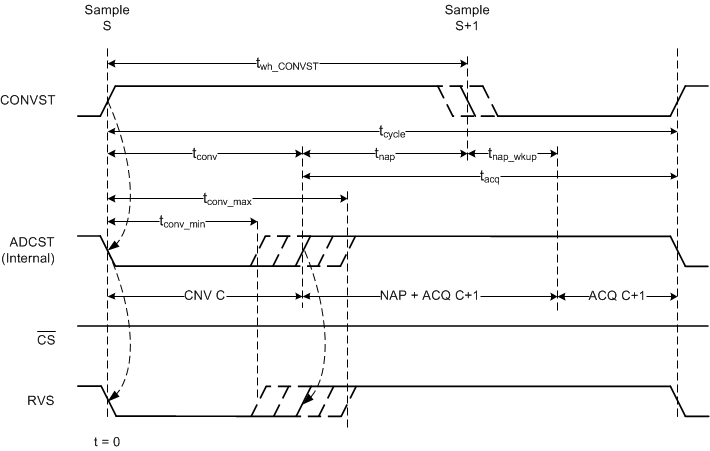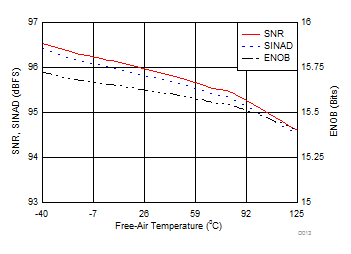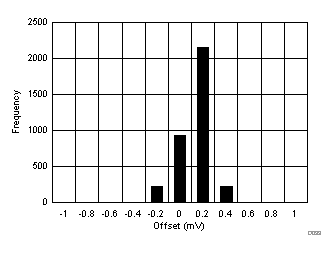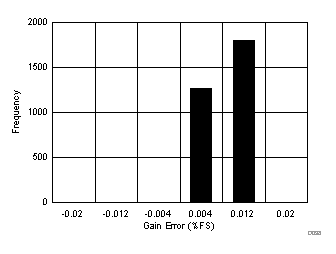JAJSCH2A September 2016 – June 2017 ADS9120
PRODUCTION DATA.
- 1 特長
- 2 アプリケーション
- 3 概要
- 4 改訂履歴
- 5 Pin Configuration and Functions
-
6 Specifications
- 6.1 Absolute Maximum Ratings
- 6.2 ESD Ratings
- 6.3 Recommended Operating Conditions
- 6.4 Thermal Information
- 6.5 Electrical Characteristics
- 6.6 Timing Requirements: Conversion Cycle
- 6.7 Timing Requirements: Asynchronous Reset, NAP, and PD
- 6.8 Timing Requirements: SPI-Compatible Serial Interface
- 6.9 Timing Requirements: Source-Synchronous Serial Interface (External Clock)
- 6.10 Timing Requirements: Source-Synchronous Serial Interface (Internal Clock)
- 6.11 Typical Characteristics
-
7 Detailed Description
- 7.1 Overview
- 7.2 Functional Block Diagram
- 7.3 Feature Description
- 7.4 Device Functional Modes
- 7.5
Programming
- 7.5.1 Data Transfer Frame
- 7.5.2 Interleaving Conversion Cycles and Data Transfer Frames
- 7.5.3 Data Transfer Protocols
- 7.5.4 Device Setup
- 7.6 Register Maps
- 8 Application and Implementation
- 9 Power-Supply Recommendations
- 10Layout
- 11デバイスおよびドキュメントのサポート
- 12メカニカル、パッケージ、および注文情報
パッケージ・オプション
メカニカル・データ(パッケージ|ピン)
- RGE|24
サーマルパッド・メカニカル・データ
- RGE|24
発注情報
6 Specifications
6.1 Absolute Maximum Ratings
over operating free-air temperature range (unless otherwise noted)(1)| MIN | MAX | UNIT | |
|---|---|---|---|
| AVDD to GND | –0.3 | 2.1 | V |
| DVDD to GND | –0.3 | 2.1 | V |
| REFP to REFM | –0.3 | 5.5 | V |
| REFM to GND | –0.1 | 0.1 | V |
| Analog (AINP, AINM) to GND | –0.3 | REFP + 0.3 | V |
| Digital input (RST, CONVST, CS, SCLK, SDI) to GND | –0.3 | DVDD + 0.3 | V |
| Digital output (RVS, SDO-0, SDO-1, SDO-2, SDO-3) to GND | –0.3 | DVDD + 0.3 | V |
| Operating temperature, TA | –40 | 85 | °C |
| Storage temperature, Tstg | –65 | 150 | °C |
(1) Stresses beyond those listed under Absolute Maximum Ratings may cause permanent damage to the device. These are stress ratings only, which do not imply functional operation of the device at these or any other conditions beyond those indicated under Recommended Operating Conditions. Exposure to absolute-maximum-rated conditions for extended periods may affect device reliability.
6.2 ESD Ratings
| VALUE | UNIT | |||
|---|---|---|---|---|
| V(ESD) | Electrostatic discharge | Human-body model (HBM), per ANSI/ESDA/JEDEC JS-001(1) | ±2000 | V |
| Charged-device model (CDM), per JEDEC specification JESD22-C101(2) | ±500 | |||
(1) JEDEC document JEP155 states that 500-V HBM allows safe manufacturing with a standard ESD control process.
(2) JEDEC document JEP157 states that 250-V CDM allows safe manufacturing with a standard ESD control process.
6.3 Recommended Operating Conditions
over operating free-air temperature range (unless otherwise noted)| MIN | NOM | MAX | UNIT | ||
|---|---|---|---|---|---|
| AVDD | Analog supply voltage | 1.8 | V | ||
| DVDD | Digital supply voltage | 1.8 | V | ||
| REFP | Positive reference | 5 | V | ||
6.4 Thermal Information
| THERMAL METRIC(1) | ADS9120 | UNITS | |
|---|---|---|---|
| RGE (VQFN) | |||
| 24 PINS | |||
| RθJA | Junction-to-ambient thermal resistance | 31.9 | °C/W |
| RθJC(top) | Junction-to-case (top) thermal resistance | 29.9 | °C/W |
| RθJB | Junction-to-board thermal resistance | 8.9 | °C/W |
| ψJT | Junction-to-top characterization parameter | 0.3 | °C/W |
| ψJB | Junction-to-board characterization parameter | 8.9 | °C/W |
| RθJC(bot) | Junction-to-case (bottom) thermal resistance | 2.0 | °C/W |
(1) For more information about traditional and new thermal metrics, see the Semiconductor and IC Package Thermal Metrics application report.
6.5 Electrical Characteristics
All specifications are for AVDD = 1.8 V, DVDD = 1.8 V, VREF = 5 V, and fDATA = 2.5 MSPS, unless otherwise noted.All minimum and maximum specifications are for TA = –40°C to +85°C, unless otherwise noted.
All typical values are at TA = 25°C.
| PARAMETER | TEST CONDITIONS | MIN | TYP | MAX | UNIT | |
|---|---|---|---|---|---|---|
| ANALOG INPUT | ||||||
| FSR | Full-scale input range (AINP – AINM)(1) |
–VREF | VREF | V | ||
| VIN | Absolute input voltage (AINP and AINM to REFGND) |
–0.1 | VREF + 0.1 | V | ||
| VCM | Common-mode voltage range (AINP + AINM) / 2 |
(VREF / 2) – 0.1 | VREF / 2 | (VREF / 2) + 0.1 | V | |
| CIN | Input capacitance | In sample mode | 60 | pF | ||
| In hold mode | 4 | |||||
| IIL | Input leakage current | ±1 | µA | |||
| VOLTAGE REFERENCE INPUT | ||||||
| VREF | Reference input voltage range | 2.5 | 5 | V | ||
| IREF | Reference input current | Average current, VREF = 5 V, 2-kHz, full-scale input, throughput = 2.5 MSPS |
1.3 | mA | ||
| DC ACCURACY | ||||||
| Resolution | 16 | Bits | ||||
| NMC | No missing codes | 16 | Bits | |||
| INL | Integral nonlinearity | TA = –40°C to +85°C | –0.6 | ±0.25(2) | 0.6 | LSB(3) |
| TA = –40°C to +125°C | –0.7 | ±0.25(2) | 0.7 | |||
| DNL | Differential nonlinearity | TA = –40°C to +85°C | –0.6 | ±0.25(2) | 0.6 | LSB |
| TA = –40°C to +125°C | –0.7 | ±0.25 | 0.7 | |||
| E(IO) | Input offset error | –1 | ±0.025(2) | 1 | mV | |
| dVOS/dT | Input offset thermal drift | 1 | μV/°C | |||
| GE | Gain error | –0.02 | ±0.01(2) | 0.02 | %FS | |
| GE/dT | Gain error thermal drift | 0.25 | ppm/°C | |||
| Transition noise | 0.35 | LSB | ||||
| CMRR | Common-mode rejection ratio | At dc to 20 kHz | 80 | dB | ||
| AC ACCURACY(4) | ||||||
| SINAD | Signal-to-noise + distortion | fIN = 2 kHz | 94.4 | 96 | dB | |
| fIN = 100 kHz | 95 | |||||
| fIN = 500 kHz | 83.9 | |||||
| SNR | Signal-to-noise ratio | fIN = 2 kHz | 94.5 | 96 | dB | |
| fIN = 100 kHz | 95.9 | |||||
| fIN = 500 kHz | 84 | |||||
| THD | Total harmonic distortion(5) | fIN = 2 kHz | –118 | dB | ||
| fIN = 100 kHz | –102 | |||||
| fIN = 500 kHz | –101 | |||||
| SFDR | Spurious-free dynamic range | fIN = 2 kHz | 120 | dB | ||
| fIN = 100 kHz | 108 | |||||
| fIN = 500 kHz | 106 | |||||
| DIGITAL INPUTS(6) | ||||||
| VIH | High-level input voltage | 0.65 DVDD | DVDD + 0.3 | V | ||
| VIL | Low-level input voltage | –0.3 | 0.35 DVDD | V | ||
| DIGITAL OUTPUTS(6) | ||||||
| VOH | High-level output voltage | IOH = 2-mA source | DVDD – 0.45 | V | ||
| VOL | Low-level output voltage | IOH = 2-mA sink | 0.45 | V | ||
| POWER SUPPLY | ||||||
| AVDD | Analog supply voltage | 1.65 | 1.8 | 1.95 | V | |
| DVDD | Digital supply voltage | 1.65 | 1.8 | 1.95 | V | |
| IDD | AVDD supply current (AVDD = 1.8 V) |
Active, 2.5-MSPS throughput, TA = –40°C to +85°C |
5 | 6.5 | mA | |
| Active, 2.5-MSPS throughput, TA = –40°C to +125°C |
5 | 6.75 | ||||
| Static, ACQ state | 3.7 | mA | ||||
| Low-power, NAP mode | 500 | µA | ||||
| Power-down, PD state | 1 | |||||
| PD | AVDD power dissipation (AVDD = 1.8 V) |
Active, 2.5-MSPS throughput, TA = –40°C to +85°C |
9 | 11.7 | mW | |
| Active, 2.5-MSPS throughput, TA = –40°C to +125°C |
9 | 12.15 | ||||
| Static, ACQ state | 6.6 | mW | ||||
| Low-power, NAP mode | 900 | µW | ||||
| Power-down, PD state | 1.8 | |||||
| TEMPERATURE RANGE | ||||||
| TA | Operating free-air temperature | –40 | 125 | °C | ||
(1) Ideal input span, does not include gain or offset errors.
(2) See Figure 9, Figure 10, Figure 25, and Figure 26 for statistical distribution data for INL, DNL, offset, and gain error parameters.
(3) LSB = least-significant bit. 1 LSB at 18 bits is approximately 3.8 ppm.
(4) All specifications expressed in decibels (dB) refer to the full-scale input (FSR) and are tested with an input signal 0.1 dB below full-scale, unless otherwise specified.
(5) Calculated on the first nine harmonics of the input frequency.
(6) As per the JESD8-7A standard. Specified by design; not production tested.
6.6 Timing Requirements: Conversion Cycle
All specifications are for AVDD = 1.8 V, DVDD = 1.8 V, VREF = 5 V, and fDATA = 2.5 MSPS, unless otherwise noted.All minimum and maximum specifications are for TA = –40°C to +85°C. All typical values are at TA = 25°C. See Figure 1.
| MIN | TYP | MAX | UNIT | ||
|---|---|---|---|---|---|
| TIMING REQUIREMENTS | |||||
| fcycle | Sampling frequency | 2.5 | MHz | ||
| tcycle | ADC cycle time period | 400 | ns | ||
| twh_CONVST | Pulse duration: CONVST high | 30 | ns | ||
| twl_CONVST | Pulse duration: CONVST low | 30 | ns | ||
| tacq | Acquisition time | 100 | ns | ||
| tqt_acq | Quiet acquisition time(1) | 25 | ns | ||
| td_cnvcap | Quiet aperture time(1) | 10 | ns | ||
| TIMING SPECIFICATIONS | |||||
| tconv | Conversion time | 270 | 290 | ns | |
(1) See Figure 47.
6.7 Timing Requirements: Asynchronous Reset, NAP, and PD
All specifications are for AVDD = 1.8 V, DVDD = 1.8 V, VREF = 5 V, and fDATA = 2.5 MSPS, unless otherwise noted.All minimum and maximum specifications are for TA = –40°C to +85°C. All typical values are at TA = 25°C. See Figure 2 and Figure 3.
| MIN | TYP | MAX | UNIT | ||
|---|---|---|---|---|---|
| TIMING REQUIREMENTS | |||||
| twl_RST | Pulse duration: RST low | 100 | ns | ||
| TIMING SPECIFICATIONS | |||||
| td_rst | Delay time: RST rising to RVS rising | 1250 | µs | ||
| tnap_wkup | Wake-up time: NAP mode | 300 | ns | ||
| tPWRUP | Power-up time: PD mode | 250 | µs | ||
6.8 Timing Requirements: SPI-Compatible Serial Interface
All specifications are for AVDD = 1.8 V, DVDD = 1.8 V, VREF = 5 V, and fDATA = 2.5 MSPS, unless otherwise noted.All minimum and maximum specifications are for TA = –40°C to +85°C. All typical values are at TA = 25°C. See Figure 4.
| MIN | TYP | MAX | UNIT | |||
|---|---|---|---|---|---|---|
| TIMING REQUIREMENTS | ||||||
| fCLK | Serial clock frequency | 75 | MHz | |||
| tCLK | Serial clock time period | 13.33 | ns | |||
| tph_CK | SCLK high time | 0.45 | 0.55 | tCLK | ||
| tpl_CK | SCLK low time | 0.45 | 0.55 | tCLK | ||
| tsu_CSCK | Setup time: CS falling to the first SCLK capture edge | 5 | ns | |||
| tsu_CKDI | Setup time: SDI data valid to the SCLK capture edge | 1.2 | ns | |||
| tht_CKDI | Hold time: SCLK capture edge to (previous) data valid on SDI | 0.65 | ns | |||
| tht_CKCS | Delay time: last SCLK falling to CS rising | 5 | ns | |||
| TIMING SPECIFICATIONS | ||||||
| tden_CSDO | Delay time: CS falling to data enable | 4.5 | ns | |||
| tdz_CSDO | Delay time: CS rising to SDO going to 3-state | 10 | ns | |||
| td_CKDO | Delay time: SCLK launch edge to (next) data valid on SDO | 6.5 | ns | |||
| td_CSRDY_f | Delay time: CS falling to RVS falling | 5 | ns | |||
| td_CSRDY_r | Delay time: CS rising to RVS rising |
After NOP operation | 10 | ns | ||
| After WR or RD operation | 70 | |||||
6.9 Timing Requirements: Source-Synchronous Serial Interface (External Clock)
All specifications are for AVDD = 1.8 V, DVDD = 1.8 V, VREF = 5 V, and fDATA = 2.5 MSPS, unless otherwise noted.All minimum and maximum specifications are for TA = –40°C to +85°C. All typical values are at TA = 25°C. See Figure 5.
| MIN | TYP | MAX | UNIT | ||
|---|---|---|---|---|---|
| TIMING REQUIREMENTS | |||||
| fCLK | Serial clock frequency | 100 | MHz | ||
| tCLK | Serial clock time period | 10 | ns | ||
| TIMING SPECIFICATIONS(1) | |||||
| td_CKSTR_r | Delay time: SCLK launch edge to RVS rising | 8.5 | ns | ||
| td_CKSTR_f | Delay time: SCLK launch edge to RVS falling | 8.5 | ns | ||
| toff_STRDO_f | Time offset: RVS rising to (next) data valid on SDO | –0.5 | 0.5 | ns | |
| toff_STRDO_r | Time offset: RVS falling to (next) data valid on SDO | –0.5 | 0.5 | ns | |
(1) Other parameters are the same as the Timing Requirements: SPI-Compatible Serial Interface table.
6.10 Timing Requirements: Source-Synchronous Serial Interface (Internal Clock)
All specifications are for AVDD = 1.8 V, DVDD = 1.8 V, VREF = 5 V, and fDATA = 2.5 MSPS, unless otherwise noted.All minimum and maximum specifications are for TA = –40°C to +85°C. All typical values are at TA = 25°C. See Figure 6.
| MIN | TYP | MAX | UNIT | |||
|---|---|---|---|---|---|---|
| TIMING SPECIFICATIONS(1) | ||||||
| td_CSSTR | Delay time: CS falling to RVS rising | 12 | 40 | ns | ||
| toff_STRDO_f | Time offset: RVS rising to (next) data valid on SDO | –0.5 | 0.5 | ns | ||
| toff_STRDO_r | Time offset: RVS falling to (next) data valid on SDO | –0.5 | 0.5 | ns | ||
| tSTR | Strobe output time period | INTCLK option | 9.9 | 11.1 | ns | |
| INTCLK / 2 option | 19.8 | 22.2 | ||||
| INTCLK / 4 option | 39.6 | 44.4 | ||||
| tph_STR | Strobe output high time | 0.45 | 0.55 | tSTR | ||
| tpl_STR | Strobe output low time | 0.45 | 0.55 | tSTR | ||
 Figure 1. Conversion Cycle Timing Diagram
Figure 1. Conversion Cycle Timing Diagram
 Figure 2. Asynchronous Reset Timing Diagram
Figure 2. Asynchronous Reset Timing Diagram
 Figure 3. NAP Mode Timing Diagram
Figure 3. NAP Mode Timing Diagram

1. The SCLK polarity, launch edge, and capture edge depend on the SPI protocol selected.
Figure 4. SPI-Compatible Serial Interface Timing Diagram
 Figure 5. Source-Synchronous Serial Interface Timing Diagram (External Clock)
Figure 5. Source-Synchronous Serial Interface Timing Diagram (External Clock)
 Figure 6. Source-Synchronous Serial Interface Timing Diagram (Internal Clock)
Figure 6. Source-Synchronous Serial Interface Timing Diagram (Internal Clock)
6.11 Typical Characteristics
at TA = 25°C, AVDD = 1.8 V, DVDD = 1.8 V, VREF = 5 V, and fSAMPLE = 2.5 MSPS (unless otherwise noted)
| Typical INL = ±0.25 LSB |

| 120 devices |

| VREF = 5 V |

| TA = 25°C |

| Standard deviation = 0.35 LSB |

| fIN = 2 kHz, SNR = 96 dB, THD = –118 dB |

| fIN = 2 kHz, VREF = 5 V |

| fIN = 2 kHz, TA = 25°C |

| VREF = 5 V, TA = 25°C |

| 3500 devices |

| VREF = 5 V |

| TA = 25°C |

| 2.5 MSPS |

| 2.5 MSPS |


| Typical DNL = ±0.25 LSB |

| 120 devices |

| VREF = 5 V |

| TA = 25°C |

| Standard deviation = 0.35 LSB |

| fIN = 100 kHz, SNR = 95.9 dB, THD = –102 dB |

| fIN = 2 kHz, VREF = 5 V |

| fIN = 2 kHz, TA = 25°C |

| VREF = 5 V, TA = 25°C |

| 3500 devices |

| VREF = 5 V |

| TA = 25°C |

| TA = 25°C |

| TA = 25°C |